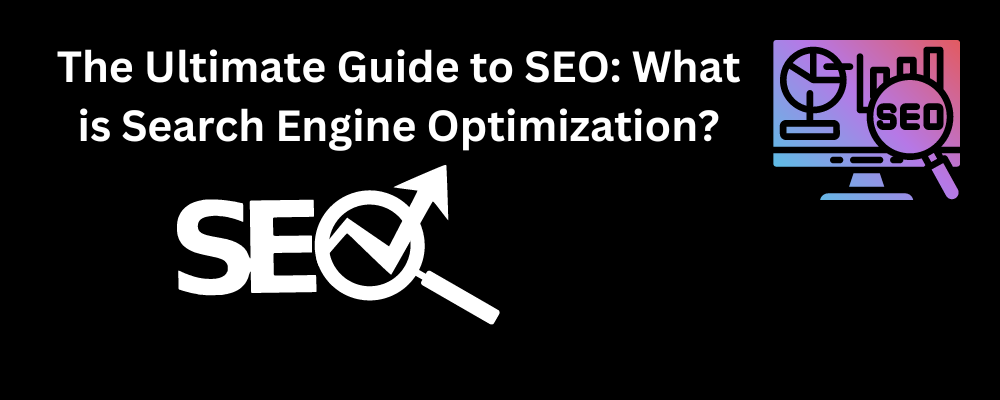Search engine optimization (SEO) is the process of improving the visibility and ranking of a website or web page in search engine results pages (SERPs). It is a set of strategies and techniques used to optimize a website in order to rank higher and earn more relevant traffic from search engines, such as Google.
Importance of SEO for businesses and websites
SEO is important for businesses and websites for several reasons:
- Increased traffic: By ranking higher in search engine results, a website can attract more qualified traffic, which can lead to more leads and sales.
- Better user experience: By optimizing a website for search engines, it can become more user-friendly and easier to navigate, which can improve the overall user experience.
- Cost-effective: SEO can be a cost-effective way to drive traffic to a website compared to other forms of online advertising, such as pay-per-click (PPC) campaigns.
- Local SEO: For local businesses, SEO can be especially important as it helps to increase the visibility of the business in local search results.
- Mobile optimization: With more and more people accessing the internet from their mobile devices, it’s important for websites to be mobile-friendly and optimized for these users. SEO can help to ensure that a website is easily accessible on mobile devices.
Overall, SEO can be a crucial component of a successful online marketing strategy, helping businesses and websites to attract more qualified traffic and achieve their online goals.
How Search Engines Work
Understanding how search engines work is an important aspect of SEO. Essentially, search engines are like giant libraries that store and index billions of web pages. When you enter a search query into a search engine, it uses its algorithms to scour its index and return the most relevant results.
So, how does this process work? Here’s an overview:
- Crawling: First, search engines use special programs called “bots” or “spiders” to discover new web pages and add them to their index.
- Indexing: Once a web page is discovered, the search engine will analyze its content and add it to its index. The index is a database of all the web pages that the search engine has discovered.
- Ranking: When a user enters a search query, the search engine uses its algorithms to sort through its index and return the most relevant results. These algorithms consider a variety of ranking factors, such as the relevance of the content to the search query, the quality of the website, and the number and quality of external links pointing to the website.
- Results: The search engine displays the results in the form of a search engine results page (SERP). The results are ranked according to their relevance to the search query, with the most relevant results appearing at the top of the page.
So, as you can see, search engines play a crucial role in helping users discover new websites and web pages. By optimizing your website for search engines, you can improve its visibility and ranking in the search results, which can ultimately lead to more traffic and success for your business or website.
Keyword Research and On-Page Optimization
Keyword research and on-page optimization are two important components of SEO. By identifying and targeting relevant keywords and optimizing your website’s content and structure, you can improve your search engine rankings and attract more qualified traffic.
Identifying and targeting relevant keywords
Identifying and targeting relevant keywords is an important aspect of SEO as it helps you to create content that addresses the needs and interests of your target audience. There are several steps you can follow to identify relevant keywords:
- Start with a brainstorming session: Think about the products or services you offer, as well as the topics that are related to your business. Make a list of potential keywords that you think people might use to find information about these products or services.
- Use keyword research tools: There are several tools available that can help you to identify relevant keywords, such as Google’s Keyword Planner or paid tools like Ahrefs or SEMrush. These tools allow you to enter seed keywords and see a list of related keywords, as well as information about the search volume and competition for each keyword.
- Analyze your competitors: Take a look at the websites of your competitors and see what keywords they are targeting. This can give you some ideas for keywords to target and can also help you to understand the level of competition for certain keywords.
- Consider the intent behind the search: When identifying keywords, it’s important to think about the intent behind the search. In other words, what is the person searching for? Are they looking for information, or are they looking to make a purchase? This can help you to target the right keywords and create content that meets the needs of your audience.
By following these steps, you can identify relevant keywords that will help you to create content that resonates with your target audience and improves your search engine rankings.
On-Page Optimization
On-page optimization refers to the process of making changes to your website’s content and structure to improve its visibility and ranking in search engine results. Here are some key elements of on-page optimization to consider:
- Page titles: The title of each page on your website should be unique and include relevant keywords. The title appears in the search results and is also used by search engines to understand the content of the page.
- Headings: Headings and subheadings (H1, H2, etc.) help to structure the content on a page and make it easier for both users and search engines to understand the main points. It’s a good idea to include relevant keywords in your headings.
- Meta descriptions: The meta description is a short summary of the page that appears in the search results. It should be written to entice users to click through to your website and should include relevant keywords.
- Content: The content on your website should be well-written, informative, and relevant to your target audience. It should also include relevant keywords in a natural way.
- URLs: The URLs for each page on your website should be descriptive and include relevant keywords. This helps both users and search engines to understand the content of the page.
By optimizing these elements of your website, you can improve its visibility and ranking in search engine results and attract more qualified traffic. Just be sure to focus on creating high-quality content that is valuable and useful to your audience, as this is ultimately what will drive the most success for your website.
Off-Page Optimization and Link Building
Off-page optimization and link building are important components of SEO that involve building links from other websites back to your own. These external links, also known as “backlinks,” can help to improve your search engine rankings and drive more qualified traffic to your website.
Importance of external links in SEO
Search engines use the number and quality of external links pointing to a website as a key ranking factor. This is because links from other websites can be seen as a “vote of confidence” in the quality and authority of your website. In other words, if other websites are linking to your website, it can be a sign that your website is valuable and worth ranking highly in search results.
However, it’s important to note that not all backlinks are created equal. Search engines also consider the quality of the linking website when determining the value of a backlink. In general, links from high-quality, authoritative websites are more valuable than links from low-quality or spammy websites.
Strategies for acquiring high-quality backlinks
There are several strategies you can use to acquire high-quality backlinks:
- Create high-quality content: One of the best ways to earn natural backlinks is to create content that is valuable and useful to your target audience. If your content is shared and linked to by other websites, it can help to improve your search engine rankings.
- Guest blogging: Consider reaching out to other websites in your industry and offering to write a guest blog post. This can be a great way to build relationships with other industry professionals and also earn a backlink to your website.
- Broken link building: This involves finding broken links on other websites and offering to replace them with a link to your own website. This can be a win-win situation, as it helps the other website to fix its broken link and also earns you a valuable backlink.
- Resource page link building: Look for resource pages on other websites in your industry and see if there is an opportunity to have your website added as a resource.
By following these strategies and building high-quality backlinks, you can improve your search engine rankings and drive more qualified traffic to your website. Just be sure to focus on building natural, high-quality links rather than trying to “trick” search engines with artificial or low-quality links.
Measuring and Tracking SEO Success
Measuring and tracking SEO success is an important part of any SEO strategy. By using tools and techniques to track your performance, you can identify any issues or areas for improvement and make adjustments to your strategy as needed.
Tools and techniques for tracking SEO performance
There are several tools and techniques you can use to track your SEO performance:
- Google Analytics: This is a free tool that provides a wealth of data about your website’s traffic and performance. You can track metrics such as pageviews, unique visitors, and bounce rate, as well as see where your traffic is coming from and what keywords are driving traffic to your website.
- Google Search Console: This is a free tool provided by Google that allows you to see how your website is performing in search results. It provides data on your search traffic, any crawl errors, and any security issues with your website.
- Rank tracking tools: There are a variety of rank tracking tools available that allow you to track the ranking of your website for specific keywords. This can help you to see how your website is performing in search results and identify any changes in your rankings over time.
- A/B testing: A/B testing involves testing different versions of your website to see which performs better. This can be a useful tool for identifying any issues or areas for improvement on your website.
Identifying and addressing any issues or areas for improvement
By tracking your SEO performance and analyzing the data, you can identify any issues or areas for improvement and make adjustments to your strategy as needed. For example, if you notice that your website’s traffic is declining, you may want to look into the reasons why and make changes to your website or SEO strategy to address the issue. Similarly, if you see that certain keywords or pages on your website are not performing well, you may want to make changes to optimize those pages or target different keywords.
By tracking your SEO performance and identifying and addressing any issues, you can improve your search engine rankings and drive more qualified traffic to your website.
Best Practices and Common Mistakes to Avoid in SEO
To achieve the best results with your SEO efforts, it’s important to follow best practices and avoid common mistakes. Here are some tips for effective SEO implementation and common mistakes to avoid:
Tips for effective SEO implementation
- Conduct thorough keyword research: Identifying relevant keywords is the foundation of any successful SEO strategy. By understanding the language that your target audience is using, you can create content that addresses their needs and interests.
- Create high-quality content: In addition to targeting relevant keywords, it’s important to focus on creating high-quality content that is valuable and useful to your target audience. This can help to improve your search engine rankings and drive more qualified traffic to your website.
- Use headings and subheadings: Headings and subheadings help to structure the content on a page and make it easier for both users and search engines to understand the main points. It’s a good idea to include relevant keywords in your headings.
- Optimize your website’s structure and navigation: A well-structured and easy-to-navigate website can help to improve the user experience and make it easier for search engines to understand the content on your website.
- Use alt tags for images: Alt tags are a text alternative for images on your website. They allow search engines to understand the content of the image and can also be used to improve the accessibility of your website for users with visual impairments.
Common mistakes to avoid in SEO
- Keyword stuffing: Overusing keywords in an unnatural way can actually hurt your SEO. It’s important to use keywords sparingly and in a way that makes sense for your content.
- Duplicate content: Having multiple pages on your website with the same or similar content can hurt your SEO as it dilutes the value of the content and can lead to confusion for search engines.
- Ignoring mobile optimization: With more and more people accessing the internet from their mobile devices, it’s important for your website to be mobile-friendly. Ignoring mobile optimization can hurt your search engine rankings and the user experience of your website.
- Not having a clear call to action: It’s important to have a clear call to action on your website to encourage users to take the next step, whether it’s filling out a form, making a purchase, or contacting you.
By following these best practices and avoiding common mistakes, you can improve your search engine rankings and drive more qualified traffic to your website.
Conclusion
In conclusion, search engine optimization (SEO) is a critical aspect of online marketing that involves optimizing your website to rank higher in search engine results and attract more qualified traffic. By following best practices and targeting the right keywords, you can improve your search engine rankings and drive more qualified traffic to your website. This can translate into more leads, sales, and revenue for your business.
Effective SEO implementation involves a combination of on-page optimization (making changes to the website itself) and off-page optimization (building links from other websites). It’s important to conduct thorough keyword research, create high-quality content, optimize your website’s structure and navigation, and use alt tags for images. It’s also important to avoid common mistakes such as keyword stuffing, duplicate content, ignoring mobile optimization, and not having a clear call to action.
By tracking your SEO performance and identifying and addressing any issues, you can continuously improve your search engine rankings and drive more qualified traffic to your website. Ultimately, SEO is an important factor in the success of any online business or website.





